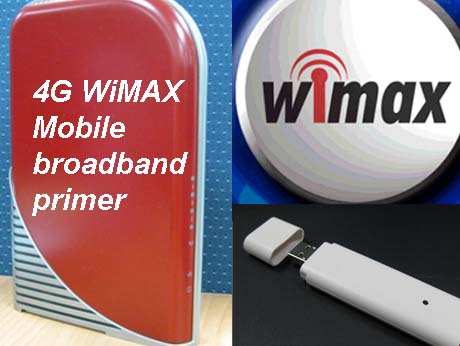
Even as the Indian auction of 3G spectrum gets underway, the shifting goalpoats of technology see the telecom industry creating solutions in 4G. To make sense of current developments ( and to help undertand the significance of IEEE's working group on 802.16m which we report on, elsewhere on this page), here is a quick primer on the related technologies, culled from Web resources which we acknowledge and link:
What is 4G? A 4G system is expected to provide a comprehensive and secure all-IP based solution where facilities such as IP telephony, ultra-broadband Internet access, gaming services and streamed multimedia may be provided to users. 4Gis also referred to as IMT Advanced (International Mobile Telecommunications Advanced), as defined by ITU-R.
An IMT advanced cellular system must have target peak data rates of up to approximately 100 Mbit/s for high mobility such as mobile access and up to approximately 1 Gbit/s for low mobility such as nomadic/local wireless access, according to the ITU requirements. Scalable bandwidths up to at least 40 MHz should be provided.
WiMAX/ IEEE 802.16
IEEE 802.16 is a series of Wireless Broadband standards authored by the IEEE. The current version is IEEE 802.16-2009 amended by IEEE 802.16j-2009.
IEEE 802.16 is written by a working group established by IEEE Standards Board in 1999 to develop standards for the global deployment of broadband Wireless Metropolitan Area Networks. The Workgroup is a unit of the IEEE 802 LAN/MAN Standards Committee.
Although the 802.16 family of standards is officially called WirelessMAN in IEEE, it has been commercialized under the name “WiMAX” (from "Worldwide Interoperability for Microwave Access") by the industry alliance called the WiMAX Forum. The mission of the Forum is to promote and certify compatibility and interoperability of broadband wireless products based on the IEEE 802.16 standards.
The most popular implementation of the IEEE 802.16 standard is the Mobile WirelessMAN originally defined by the 802.16e-2005 amendment that is now in process of being deployed around the world in more than 140 countries by more than 475 operator
http://en.wikipedia.org/wiki/IEEE_802.16
The push to 802.16m 802.16m, which "could push data transfer speeds up to 1Gbps while maintaining backwards compatibility with existing WiMAX radios.This amendment, known as 802.16m, is designed to meet or exceed the requirements of IMT-Advanced (the 4th generation of cellular systems). With a number of stringent requirements for backwards compatibility, the 802.16m amendment will provide the basis for WiMAX System Release 2 and provide existing WiMAX operators a graceful migration path to gain performance enhancements and add new services. The IEEE 802.16m task group has more than 300 participating individuals from approximately 100 organizations from two dozen countries. Completion of the IEEE 802.16m specification is expected in the 3rd quarter of 2010 with ratification soon thereafter. Initial availability of WiMAX System Release 2 products based on 802.16m is anticipated in the 2012 timeframe.
http://www.rfglobalnet.com/download.mvc/WiMAX-And-The-IEEE-80216m-Air-Interface-Stand-0001
Speeding Up WiMax
Carl Weinschenk speaks to Dr. Mohammad Shakouri, the vice president of the WiMAX Forum , laying out how WiMAX is different from LTE....
….WiMax technology overall is meant to be complementary to cellular 3G. It’s not meant to replace cellular networks. This is a multimedia network where you want to do VoIP sessions, video, and use the Internet. As we go from WiMax 1 to WiMax 1 Enhanced, we have increased simultaneous users, VoIP users, on the network and increased data rates. ….most people think LTE and WiMax will compete. The WiMax that is presently commercially deployed is similar to the LTE that is being developed by the cellular industry. WiMax 2 is similar to LTE Advanced that is planned. I think at this moment they are two different industries. WiMax is coming from the computer industry, the Internet community. LTE is coming from the cellular industry. For example, close to 20 or 25 percent of WiMax deployments are by mobile operators. Some will overlay WiMax and some will overlay LTE depending on the spectrum they have. WiMax is TDD – time division duplex – and most cellular spectrum is FDD. They are not competing in the same way at all……
http://www.itbusinessedge.com/cm/community/features/interviews/blog/speeding-up-wimax/?cs=40726
WiMAX FAQ from the WiMAX Forum
http://www.wimaxforum.org/sites/wimaxforum.org/files/page/2009/12/wimaxforum_faq%20_may272009.pdf